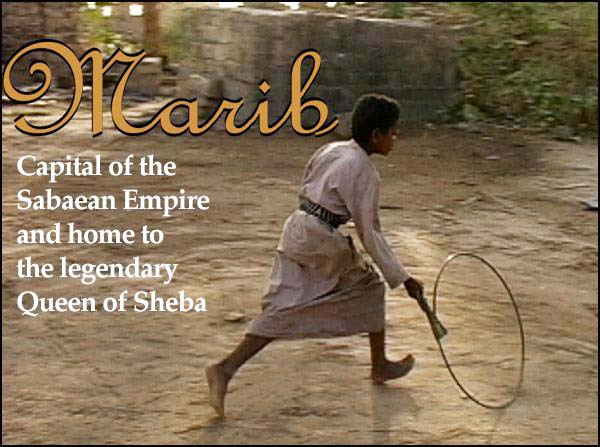
©ViewZone Expedition 2001
Old Marib, founded in about 1,200 B.C., was once a powerful political capital and still bears the markings of its past grandeur. [Map of Yemen]. With only two days to explore the area, we spent our time inspecting the ancient Bar'an Temple and the crumbling beauty of Old Marib -- including the old Marib Dam. Like an abandoned island, Old Marib (left) appeared deserted and in ruins. We were surprised to see that there were families and children (below right) occupying this ancient site.
The style of life that appeared in many of the little towns on our way to Marib from Sana'a had been bleak and rough. Cement, corrugated metal, well handled guns, farm animals and trucks were prevalent. Marib was the last oasis; the last bit of civilization we experienced before we joined the Bedouins and explored the enchanted desert.
Daughter of the jinn
Cleopatra and Antony, Napoleon and Josephine, Nicholas and Alexandra are a few of the doomed couples of history. Here, in the desert, is to be found the epic tale of Solomon and Saba [pronounced She-ba].
The Queen of Sheba is also known to the Yemeni as Bilquis. Bilquis was said to have been the daughter of a jinn, a Yemeni spirit. She came from the sand to build and rule one of the most well known empires in the old world.
What happened to the love that this queen held for the king? The missing chapters have not yet been discovered -- only myths of a special marriage, a son, and the Ark of the Covenant. Like many of Yemen's old temples, dams and carved stone records, the desert sand has hidden the end of the story. Someday, perhaps sifting through the dunes, the story will be completed.
Camels with blinders on their eyes walked in steady circles around a metal barrel. We were understandably confused.
"Bas," Ahmed told Abdul. Stop."
We pulled to the side of the road to check out this circling camel. In the barrel we found sesame seeds being ground into a pulp.
"For the camel," the animal's keeper told me, "Taste!"
He dipped his hand into the barrel and licked his fingers. Well, if he could do it... I dipped my fingers to sample the finest in camel cuisine. The dark paste looked dubious, but the taste was not so bad. It was like a bland humus.
The main street of Marib (left) was checkered with brightly painted metal doors, coloring an otherwise sandy and monotone landscape. Although most male residents of Marib were armed with AK47's or M-16s, their peaceful manners and bright smiles were effective in disarming any threats or fears. Like many small cities, there were shai restaurants on almost every corner. Gary was quick to locate one and was rapidly becoming known as "Mister Shai."
The four-star Bilquis Hotel was a gracious and spacious affair. "Like the Queen of Sheba" is a common metaphor for luxurious living. Coming in dusty from the road, the red carpet was sweet to step on.
We were so well pampered that even our beach towels were set out and then nicely folded by the attentive house keeping staff after being carelessly dropped on the floor after the morning swim. Personally speaking, I could get used to this kind of attention.
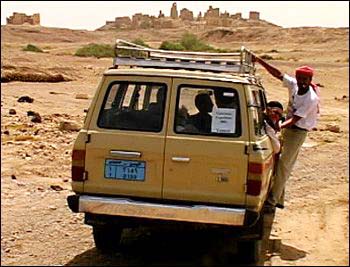 On the desert's edge
On the desert's edge
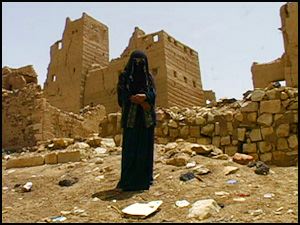 From the Koran's Surah XXVII ("The Ant") we learned of the innovation King Solomon extended to Sheba, to visit his kingdom in the North. In the Bible's The Song of Solomon and I Kings; Chapter 10 revealed that Sheba loved Solomon.
From the Koran's Surah XXVII ("The Ant") we learned of the innovation King Solomon extended to Sheba, to visit his kingdom in the North. In the Bible's The Song of Solomon and I Kings; Chapter 10 revealed that Sheba loved Solomon.
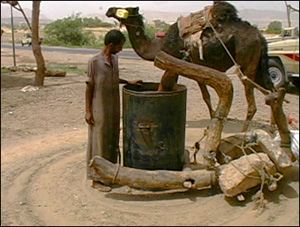 Everyday life
Everyday life
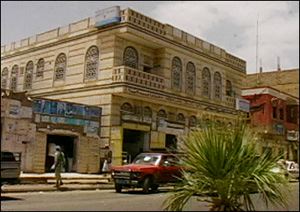
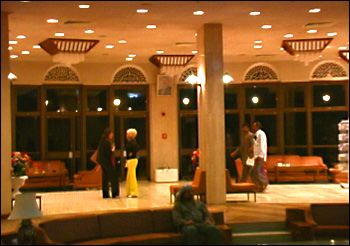
Marib was a major stop on the caravan routes of the days of old. This jewel of the Dhana Valley holds some of the most ancient and magnificent pieces of Yemeni history.
Clickable Map of Yemen
<--Previous Page || ViewZone || Next-->